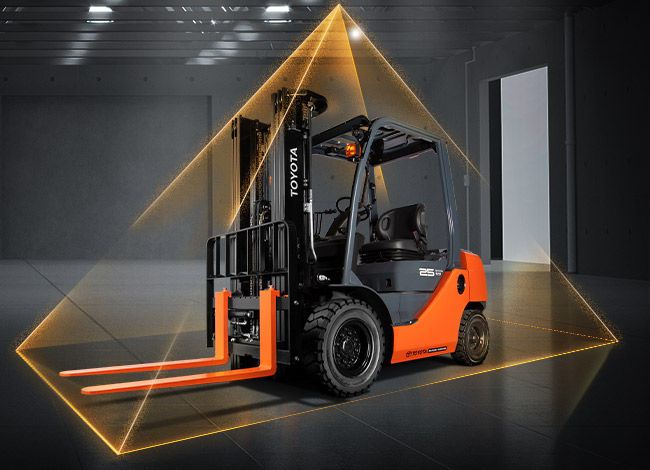Every year, an alarming number of forklift operators are involved in workplace accidents. According to the Worksafe Victoria (Forklift Safety – Reducing the Risk), lateral tip-over is a leading contributor for workplace accidents.
These tip-overs occur when a forklift takes a corner too sharp or too fast, increasing the lateral gravitational force of the forklift into a dangerous zone. If the forklift's centre of gravity shifts outside its three support points – or as we call it, the stability triangle – wheels can lift, and the unit can tip over. This can result in serious operator injury, including permanent disability, or even death.
For us at Toyota Material Handling Australia (TMHA), forklift safety is vitally important. It’s as much a part of our business as it is yours, and just one of the Advantages you benefit from when you choose to partner with Toyota. We at TMHA are a are a technology leader in forklift safety. We were the first to respond to this safety issue with our exclusive, leading-edge “System of Active Stability” (SAS), which is available on selected 8-Series models.
SAS was pioneered over 20 years ago and is the first system in the world to monitor and control the forklift through a combination of advanced sensors linked to an on-board controller, enabling superb load-handling performance with outstanding safety.
The SAS concept took more than 65 of our dedicated engineers over two years to design and is protected by over 250 patents. It’s quite a feat that since its introduction in 1998, over 500,000 SAS-equipped forklifts have been sold, globally.
SAS is similar in concept to Anti-Lock Brake Systems (ABS) and Vehicle Stability Control Systems, in that it significantly contributes to accident-prevention by enhancing control in the stability range of the forklift before it enters into a range of unstable operation.
SAS sensors detect motion during operation and the computer analyses the potential for a tip-over. If the computer determines that the potential for a tip-over exists, it sends a signal to the appropriate actuators which then operate to minimise the potential for such an accident.
All of these innovations are based on the fact that the stability of a forklift changes constantly due to shifts in the balance of the load coupled with the speed and turning rate of the forklift. Protecting your most valuable assets, SAS makes over 3000 calculations per-second, delivering class-leading stability, safety and assisting accident-prevention.
SAS can also help your business drive-down your operator costs and damage costs, resulting in a significant overall reduction. With SAS, workflow becomes safer and faster, improving productivity. These areas can collectively account for more than 70 percent of forklift's total operating costs. SAS can deliver immediate savings, protecting your drivers and your bottom line.
SAS reacts through two key systems: the Active Control Rear Stabiliser and the Active Mast Function Controller, providing excellent lateral stability and when handling loads.
The Active Control Rear Stabiliser uses information from various sensors to determine if the forklift has entered into a potentially dangerous situation, such as swinging to one side when making a turn. If a potentially dangerous condition is determined, the Active Control Rear Stabiliser temporarily locks the swinging of the rear axle to provide a high level of stability for the forklift.
Without SAS a forklift can exceed its stability limits, causing it to roll over. With SAS, the Active Rear Stabiliser locks the swinging motion of the rear axle to provide the forklift with a high level of lateral stability. Although they certainly help to create a safer work environment, SAS’ innovative features, as advanced as they are, do not override the value of sensible employees, professional training and strict adherence to safety regulations.
Talk to us today about how our SAS equipped forklifts can assist in making your workplace a safer environment.

Toyota's SAS equipped forklifts can assist in making your workplace a safer environment. (Safety prism shown for illustration purposes only)

